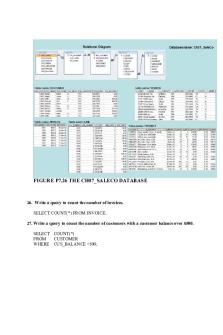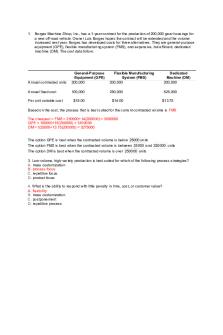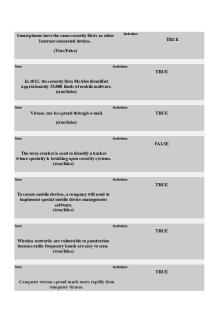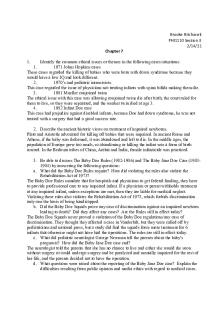CF1 Exercise Ch7 Solution PDF

| Title | CF1 Exercise Ch7 Solution |
|---|---|
| Course | Corporate Finance |
| Institution | Fachhochschule Südwestfalen |
| Pages | 4 |
| File Size | 130.8 KB |
| File Type | |
| Total Downloads | 90 |
| Total Views | 184 |
Summary
solutions to the casestudies...
Description
Chapter 7: Valuing Bonds 1. Dividend Yield. Favored stock will pay dividend this year of $2.40 per share. Its dividend yield is 8%. At what price is the stock selling? 2. Stock Values. Integrated Potato Chips paid is 1$ per share dividend yesterday. You expected the dividend to grow steadily at the rate of 4% per year. a. What is the expected dividend in each of the next 3 years? b. If the discount rate for the stock is 12%, at what price will the stock sell? c. What is the expected stock price 3 years from now? d. If you buy the stock and plan to hold it for 3 years, what payments will you receive? What is the present value of those payments? Compare your answer to (b). 3. Constant Growth Model. A stock sells for $40. The next dividend will be $4 per share. If the rate of return earned on reinvested funds is 15% and the company reinvests 40% of earnings in the firm, what must be the discount rate? 4. Constant Growth Model. Gentle man Gym just paid its annual dividend for $3 per share, and it is widely expected that the dividend will increase by 5% per year indefinitely. a. What price should the stock sell at? The discount rate is 15% b. How would you answer change if the discount rate were only 12%? Why does the answer change? 5. Constant Growth Model. Eastern Electric currently pays a dividend of about $1.64 per share and sells for $27 a share. a. If investors believe the growth rate of dividends is 3% per year, what rate of return do they expected to earn on the stocks? b. If investors´ required rate of return is 10%, what must be the growth rate they expect of the firm? 6. Constant Growth Model. Here are data on two stocks, both of which have discount rates of 15%: Stock A Stock B Return on equity 15% 10% Earnings per share $ 2.00 $1.50 Dividends per share $1.00 $1.00 a. What are the dividend payout ratios for each firm? b. What are the expected dividend growth rates for each firm? c. What is the proper stock price for each firm? 7. P/E Ratios. Web Cites Research projects a rate of return of 20% on new projects. Management plans to plow back 30% of all earning into the firm. Earning this year will be $3 per share and investors expect a 12% rate of return on stocks facing the same risk as Web Cites.
a. b. c. d. e.
What is he sustainable growth rate? What is the stock price? What is the present value of growth opportunities? What is the P/E ratio be if the firm paid out all earning as dividends? What do you conclude about the relationship between growth opportunities and P/E ratios?
8. Information and Efficient Markets. “Its competition for information that makes securities markets efficient.” Is this statement correct? Explain. 9. Behavioral Finance. Some finance scholars cite well-documented behavioral biases to explain apparent cases of the market inefficiency. Describe two of these biases.
Solutions: 1.
Dividend yield = Dividend/Price = DIV1/P0 0.08 = 2.40/P0 P0 = $30
2.
a.
DIV1 = $1 1.04 = $1.04 DIV2 = $1 1.042 = $1.0816 DIV3 = $1 1.043 = $1.1249
b.
P0 =
DIV1 $1.04 $13.00 r g 0.12 0.04
c.
P3 =
DIV4 $1.1249 1.04 $14.6237 r g 0.12 0.04
d.
Your payments will be: DIV Selling Price Total Cash Flow PV of Cash Flow
Year 1 $1.04
Year 2 $1.0816
$1.04 $0.9286
$1.0816 $0.8622
Year 3 $1.1249 14.6237 $15.7486 $11.2095
Sum of PV = $13.00, the same as the answer to part (b). 3.
4.
g = return on equity plowback ratio = 0.15 0.40 = 0.06 = 6.0% 40
4 4 r 0.06 0.16 16.0% 40 r 0.06
a.
P0
DIV1 $3 1.05 $31.50 r g 0.15 0.05
b.
P0
$3 1.05 $45 0.12 0.05
The lower discount rate makes the present value of future dividends higher. 5.
a.
r = DIV1/P0 + g = [($1.64 1.03)/27] + 0.03 = 0.0926 = 9.26%
b.
If r = 0.10, then: 0.10 = [($1.64 1.03)/27] + g g = 0.0374 = 3.74%
c.
g = return on equity plowback ratio 5% = return on equity 0.4 return on equity = 0.125 = 12.5%
6.
7.
Stock A $1/$2 = 0.50
Stock B $1/$1.50 = 0.67
15% 0.5 = 7.5%
10% 0.333 = 3.33%
a.
Payout ratio
b.
g = ROE plowback ratio
c.
Pr ice
a.
g = ROE plowback ratio = 20% 0.30 = 6%
b.
E = $3, r = 0.12 P0
c.
No-growth value = E/r = $3/0.12 = $25.00
DIV1 r g
$1 $1 $13.33 $8.57 0.15 0.075 0.15 0.0333
$3(1 0.30) $35 .00 0.12 0.06
PVGO = P0 No-growth value = $35 $25 = $10
8.
d.
P/E = $35/$3 = 11.667
e.
If all earnings were paid as dividends, price would equal the no-growth value ($25) and P/E would be: $25/$3 = 8.333
f.
High P/E ratios reflect expectations of high PVGO.
The statement is correct. The search for information and insightful analysis makes investor assessments of stock values as reliable as possible. Since the rewards accrue to the investors who uncover relevant information before it is reflected in stock prices, competition among these investors means that there is always an active search for mispriced stocks.
9.
The two broad areas of investors’ behavioral biases are in their attitudes towards risk and their assessments of probabilities. Investors appear to be less averse to losses following substantial gains than they are to losses that follow other losses. Consequently, the early gains of the “dot-com bubble” may have led investors to increase their investments in dot-com stocks, leading to the tremendous gains leading up to March 2000. In addition, psychologists believe that investors make two mistakes in their assessment of stock market probabilities. First, when assessing the future of stock market performance, investors attach too much importance to the recent past, largely ignoring events of the more distant past. Second, investors suffer from overconfidence, believing that they are better stock pickers than they are in reality. These two biases reinforced the bubble prior to March 2000: overconfident investors attached too much importance to their experiences during the preceding five years....
Similar Free PDFs

CF1 Exercise Ch7 Solution
- 4 Pages

SM CH02 - solution manuals CH7
- 87 Pages

Ch7 - Ch7
- 11 Pages

Ch7
- 4 Pages

Exercise 1 solution
- 6 Pages

VLSM Exercise Solution
- 4 Pages

Exercise 3-Solution
- 2 Pages

Week 2 exercise - solution
- 3 Pages

Testbank ch7
- 4 Pages

PHI1110 CH7
- 3 Pages
Popular Institutions
- Tinajero National High School - Annex
- Politeknik Caltex Riau
- Yokohama City University
- SGT University
- University of Al-Qadisiyah
- Divine Word College of Vigan
- Techniek College Rotterdam
- Universidade de Santiago
- Universiti Teknologi MARA Cawangan Johor Kampus Pasir Gudang
- Poltekkes Kemenkes Yogyakarta
- Baguio City National High School
- Colegio san marcos
- preparatoria uno
- Centro de Bachillerato Tecnológico Industrial y de Servicios No. 107
- Dalian Maritime University
- Quang Trung Secondary School
- Colegio Tecnológico en Informática
- Corporación Regional de Educación Superior
- Grupo CEDVA
- Dar Al Uloom University
- Centro de Estudios Preuniversitarios de la Universidad Nacional de Ingeniería
- 上智大学
- Aakash International School, Nuna Majara
- San Felipe Neri Catholic School
- Kang Chiao International School - New Taipei City
- Misamis Occidental National High School
- Institución Educativa Escuela Normal Juan Ladrilleros
- Kolehiyo ng Pantukan
- Batanes State College
- Instituto Continental
- Sekolah Menengah Kejuruan Kesehatan Kaltara (Tarakan)
- Colegio de La Inmaculada Concepcion - Cebu





